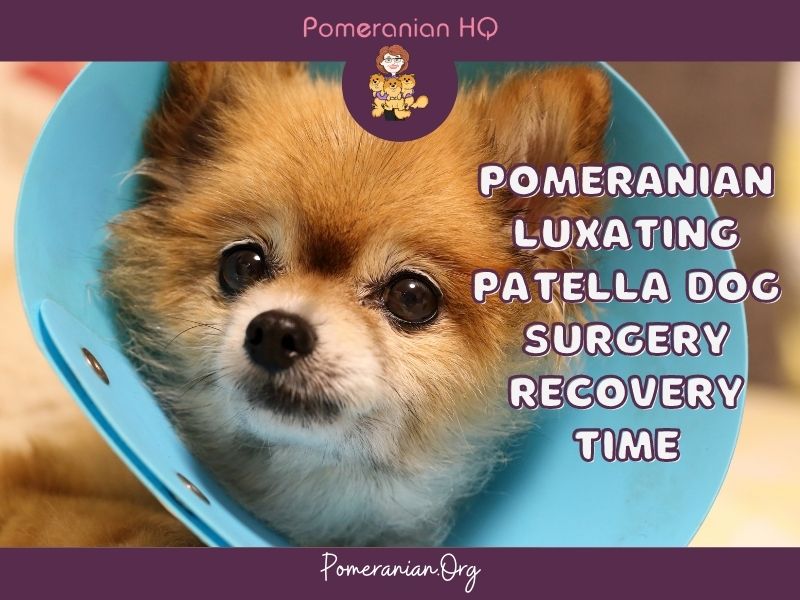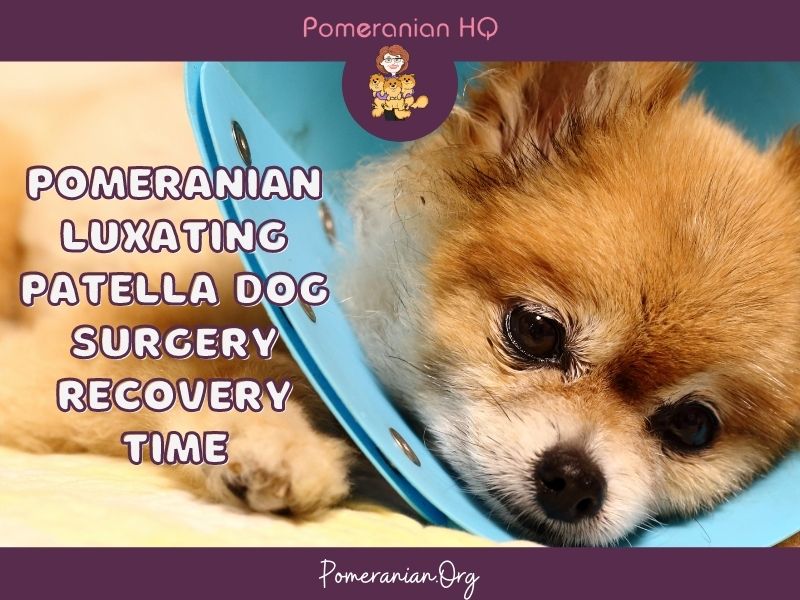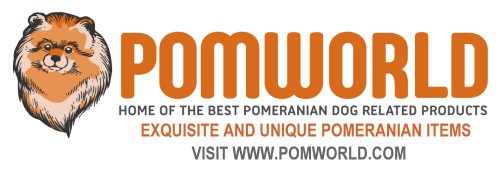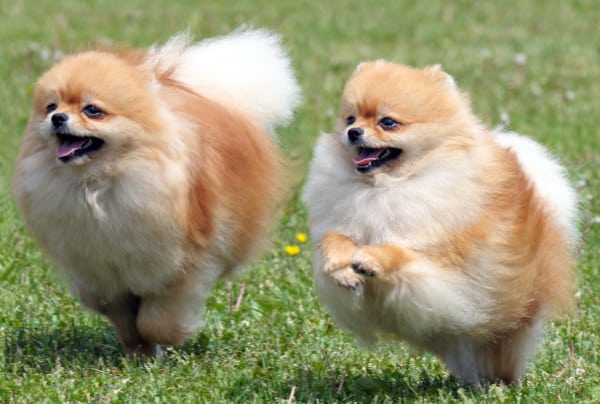Last Updated on 02/05/2022 by Dochlaggie. Post first published on March 5, 2022.
Pomeranians are one of the dog breeds that typically face problems with their knee joints. If a kneecap gets injured or isn’t formed properly, it can slip out of position and that’s very painful.
This is known as a luxating patella. If your Pomeranian undergoes surgery to correct the luxating patella and stabilize the knee cap, it’s important to know the luxating patella surgery recovery process for Pomeranian dogs.
N.B. This article regarding Pomeranian health issues was written in consultation with our resident veterinarian.

The Timeline for Luxating Patella Dog Surgery Recovery Process
Straight after surgery, the majority of Pomeranians will visibly show they feel a degree of tenderness in the knee joint and will limit their range of movement as much as they can.
Some will feel a little improvement immediately or simply won’t be able to contain their high-spirited personalities. However, it’s absolutely essential that you follow all restrictions related to exercise that the surgeon suggests so your Pom recovers quickly from surgical techniques to correct the luxating patella.
When you bring your Pomeranian home, these are the steps you need to follow:
- Confine your Pomeranian to a playpen and restrict walking as much as possible during the first few weeks.
- Feed your Pomeranian a healthy diet and ensure he does not gain weight during the convalescence period.
For the first few days after surgery, you must carry your Pom up and down all steps for a few reasons:
- If the weather is icy and/or wet outside, it’s possible he may slip and hurt himself.
- The area around his potty spot may be wet, muddy or slippery.
- It will take a little while to heal and to feel confident walking again.
Only start to exercise your Pom if your vet approves (and this may mean a check-up before approval is given).
Once your vet gives the o.k., start by placing your Pom on his leash and taking him for 5-minute walks. If he exhibits any signs of pain or strain on the knee joint, stop.
If he has signs of constant pain on the short walks, ring the vet and book him in to be fully checked again. On the other hand, if your Pom is coping, slowly increase the walks as long as he appears healthy enough to manage.
Pomeranian parents need to be aware that the healing process may take up to 12 weeks, and complications like wound contamination and infection can happen and may hinder your dog’s progress.
Your dog will require a vet examination after the fourth day for dressing changes as well as possible carprofen injections every week until it has healed.
Luxating Patella Dog Surgery Recovery Process
After your Pomeranian has undergone surgery to correct a luxating patella, it’s essential that dog owners have an idea of dog patellar luxation surgery recovery rate over an average week. Obviously, your Pom’s recovery timeline might not be exactly the same as this, but the similarities will still be there.
Strict rest means no free exercise for the next 6-8 weeks to leg heal and stabilize the joint for most dogs.
After that Initial Week
This first week is your Pomeranian’s recovery after luxating patellar surgery. If everything is going smoothly, you may like to get ahead and take a few steps in the next recovery period.
If you see any swelling, contact your vet for advice. Cold packs may be prescribed for a day or two post-surgery. Unless there are problems such as obvious swelling or you’re advised to keep going by your vet, you can stop using cold packs.
Start applying moist heat with a commercial product. Ensure the device’s temperature isn’t too hot for small dogs to handle. People are commonly told that if they make a rice bag, put it in a microwave so they have moist heat. However, they can also say something if you have made the bag too hot.
Regardless of the product chosen, make it warm, not hot when you touch it. If you’re not positive about it, use a washcloth and make it warm by putting it in lukewarm water as it will be the gentlest choice.
If your vet has no objections, use the heating option right before he exercises because it will help make the healing joints more flexible.

Two to Three Weeks After Luxating Patella Surgery
This is the second phase of your Pom’s recovery from luxating patella surgery. In lots of cases, your vet is happy to assess his condition and see if he is progressing at a good pace.
The stitches will have been removed at the vet’s office.
He may advise you on suitable “at home” therapy. Follow your vet’s advice to the letter, but if your Pom shows any sign of pain, stop immediately.
Two to three weeks after surgery, you should start your dog on physiotherapy. A passive range of motion exercises is done in each session for ten flexions and extensions on each joint with no force or pain-causing movement included.
Four to Six Weeks Post Luxating Patella Dog Surgery
This is your Pom’s third phase of recovery from the luxating patellar and the typical timeline. Again, don’t exercise your Pomeranian unless given the go-ahead by your vet. Avoid slippery surfaces, and stairs, and no jumping up and down from furniture.
Luxating Patella in Dogs Recovery Beyond Eight Weeks
This is the fourth and final phase of your Pomeranian’s recovery timeline. Get the vet to evaluate his overall health at the nine-week point. He may make extra suggestions to add to the luxating patellar recovery timeline.
Sit-to-stand exercises are great for building quadriceps muscle mass. They should start at six weeks and continue until your dog reaches the 12 – 16 week post-operation period.
After recovery, exercise and hydrotherapy (swimming) are required for better joint mobility and strengthening of muscles. By 12-16 weeks your dog should have normal activity; otherwise, make an appointment with your vet for a physical examination.
Some vets are keen to give you permission to do a lot more activities, except for high-impact exercises that could still undo all the hard work already put in. Your Pomeranian should avoid running until the vet has given you permission to get your Pom back into his normal routine, which usually occurs around week twelve to sixteen.
Pomeranian Luxating Patella Surgery Recovery Final Thoughts
Be guided by your vet and also by the level of activity your Pomeranian is happy with and keen to achieve. The success rate of luxating patella surgery in dogs depends on the skill of the surgeon and the at-home management after surgery.
Please note: while I do discuss health, care, and behavioral issues, you should never use this information as a replacement for advice from qualified veterinarians, diagnoses, or recommended treatment regimes. If you have any worries about the health of your Pomeranian, your first contact should be your regular vet or, if you don’t yet have one, a vet that works locally. Never ignore or avoid treatment and advice from your vet because of a piece of information you have read on any website.
N.B. This article regarding Pomeranian health issues was written in consultation with our resident veterinarian.
Dr. Muqeet Mushtaq
DVM, University of Animal and Veterinary Sciences, 2019
MSc. (Hons.) (Animal Breeding & Genetics), University of Agriculture Faisalabad, 2021
Copyright Pomeranian.org. All Rights Reserved.
References and Further Reading:
[1] Official Standard of the Pomeranian (AKC). American Kennel Club, 2011.
[2] English Kennel Club Pomeranian Breed Standard, 2017.
[3] Denise Leo, The Pomeranian Handbook.
[4] Milo G. Denlinger “The Complete Pomeranian.”
[5] Kimbering Pomeranians “1891-1991”.
[6] William Taplin’s “The Sportsman’s Cabinet.”
[7] E. Parker “The Popular Pomeranian.”
[8] Lilla Ives “Show Pomeranians.”










